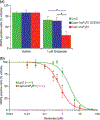Calpain-cleaved type 1 inositol 1,4,5-trisphosphate receptor impairs ER Ca(2+) buffering and causes neurodegeneration in primary cortical neurons
- PMID: 22762283
- PMCID: PMC6718092
- DOI: 10.1111/j.1471-4159.2012.07859.x
Calpain-cleaved type 1 inositol 1,4,5-trisphosphate receptor impairs ER Ca(2+) buffering and causes neurodegeneration in primary cortical neurons
Abstract
Disruption of neuronal Ca(2+) homeostasis plays a well-established role in cell death in a number of neurodegenerative disorders. Recent evidence suggests that proteolysis of the type 1 inositol 1,4,5-trisphosphate receptor (InsP(3)R1), a Ca(2+) release channel on the endoplasmic reticulum, generates a dysregulated channel, which may contribute to aberrant Ca(2+) signaling and neurodegeneration in disease states. However, the specific effects of InsP(3)R1 proteolysis on neuronal Ca(2+) homeostasis are unknown, as are the functional contributions of this pathway to neuronal death. This study evaluates the consequences of calpain-mediated InsP(3)R1 proteolysis on neuronal Ca(2+) signaling and survival using adeno-associated viruses to express a recombinant cleaved form of the channel (capn-InsP(3)R1) in rat primary cortical neurons. Here, we demonstrate that expression of capn-InsP(3)R1 in cortical cultures reduced cellular viability. This effect was associated with increased resting cytoplasmic Ca(2+) concentration ([Ca(2+)](i)), increased [Ca(2+)](i) response to glutamate, and enhanced sensitivity to excitotoxic stimuli. Together, our results demonstrate that InsP(3)R1 proteolysis disrupts neuronal Ca(2+) homeostasis, and potentially acts as a feed-forward pathway to initiate or execute neuronal death.
© 2012 The Authors. Journal of Neurochemistry © 2012 International Society for Neurochemistry.
Conflict of interest statement
Conflict of interest
The authors declare no conflict of interest.
Figures





Similar articles
-
Calpain-cleaved type 1 inositol 1,4,5-trisphosphate receptor (InsP(3)R1) has InsP(3)-independent gating and disrupts intracellular Ca(2+) homeostasis.J Biol Chem. 2011 Oct 14;286(41):35998-36010. doi: 10.1074/jbc.M111.254177. Epub 2011 Aug 22. J Biol Chem. 2011. PMID: 21859719 Free PMC article.
-
The high-affinity calcium[bond]calmodulin-binding site does not play a role in the modulation of type 1 inositol 1,4,5-trisphosphate receptor function by calcium and calmodulin.Biochem J. 2002 Aug 1;365(Pt 3):659-67. doi: 10.1042/BJ20011789. Biochem J. 2002. PMID: 11972451 Free PMC article.
-
Apoptosis regulation by Bcl-x(L) modulation of mammalian inositol 1,4,5-trisphosphate receptor channel isoform gating.Proc Natl Acad Sci U S A. 2007 Jul 24;104(30):12565-70. doi: 10.1073/pnas.0702489104. Epub 2007 Jul 16. Proc Natl Acad Sci U S A. 2007. PMID: 17636122 Free PMC article.
-
Inositol 1,4,5-trisphosphate receptor-isoform diversity in cell death and survival.Biochim Biophys Acta. 2014 Oct;1843(10):2164-83. doi: 10.1016/j.bbamcr.2014.03.007. Epub 2014 Mar 15. Biochim Biophys Acta. 2014. PMID: 24642269 Review.
-
Mitochondrial Ca(2+) signals in autophagy.Cell Calcium. 2012 Jul;52(1):44-51. doi: 10.1016/j.ceca.2012.03.001. Epub 2012 Mar 28. Cell Calcium. 2012. PMID: 22459281 Free PMC article. Review.
Cited by
-
Fragmented inositol 1,4,5-trisphosphate receptors retain tetrameric architecture and form functional Ca2+ release channels.J Biol Chem. 2013 Apr 19;288(16):11122-34. doi: 10.1074/jbc.M113.453241. Epub 2013 Mar 11. J Biol Chem. 2013. PMID: 23479737 Free PMC article.
-
Calpain in Traumatic Brain Injury: From Cinderella to Central Player.Cells. 2025 Aug 14;14(16):1253. doi: 10.3390/cells14161253. Cells. 2025. PMID: 40862734 Free PMC article. Review.
-
Differential regulation of ion channels function by proteolysis.Biochim Biophys Acta Mol Cell Res. 2018 Nov;1865(11 Pt B):1698-1706. doi: 10.1016/j.bbamcr.2018.07.004. Epub 2018 Jul 17. Biochim Biophys Acta Mol Cell Res. 2018. PMID: 30009861 Free PMC article. Review.
-
Caspase 3 cleavage of the inositol 1,4,5-trisphosphate receptor does not contribute to apoptotic calcium release.Cell Calcium. 2013 Feb;53(2):152-8. doi: 10.1016/j.ceca.2012.10.002. Epub 2012 Nov 2. Cell Calcium. 2013. PMID: 23122728 Free PMC article.
-
Honokiol induces apoptosis-like death in Cryptocaryon irritans Tomont.Parasit Vectors. 2023 Aug 16;16(1):287. doi: 10.1186/s13071-023-05910-1. Parasit Vectors. 2023. PMID: 37587480 Free PMC article.
References
-
- Assefa Z, Bultynck G, Szlufcik K, Nadif Kasri N, Vermassen E, Goris J, Missiaen L, Callewaert G, Parys JB and De Smedt H (2004) Caspase-3-induced truncation of type 1 inositol trisphosphate receptor accelerates apoptotic cell death and induces inositol trisphosphate-independent calcium release during apoptosis.J. Biol. Chem 279, 43227–43236. - PubMed
-
- Bardo S, Cavazzini MG and Emptage N (2006) The role of the endoplasmic reticulum Ca2+ store in the plasticity of central neurons. Trends Pharmacol. Sci 27, 78–84. - PubMed
-
- Berridge MJ, Lipp P and Bootman MD (2000) The versatility and universality of calcium signalling. Nat. Rev. Mol. Cell Biol 1, 11–21. - PubMed
-
- Berridge MJ, Bootman MD and Roderick HL (2003) Calcium signalling: dynamics, homeostasis and remodelling. Nat. Rev. Mol. Cell Biol 4, 517–529. - PubMed
Publication types
MeSH terms
Substances
Grants and funding
LinkOut - more resources
Full Text Sources
Miscellaneous

